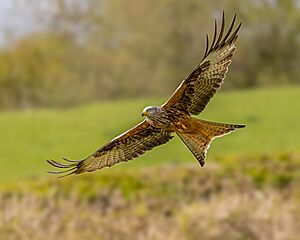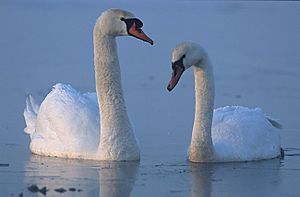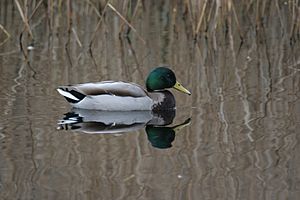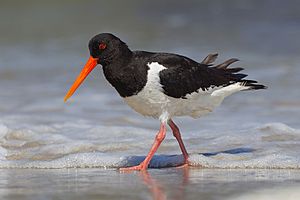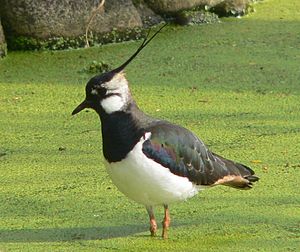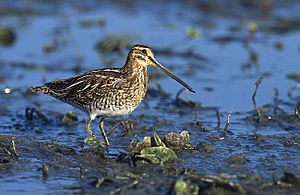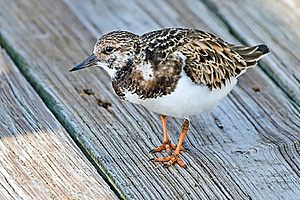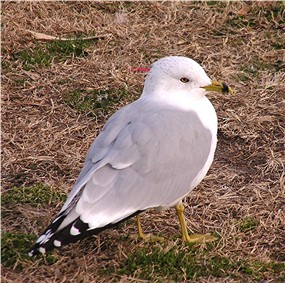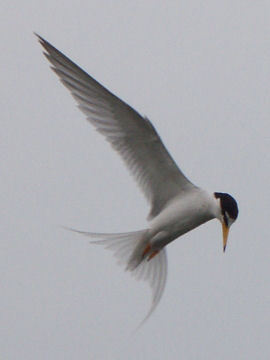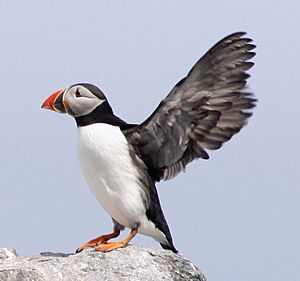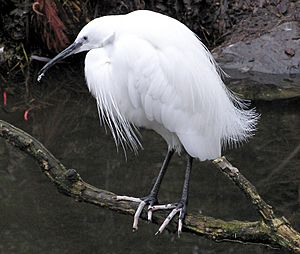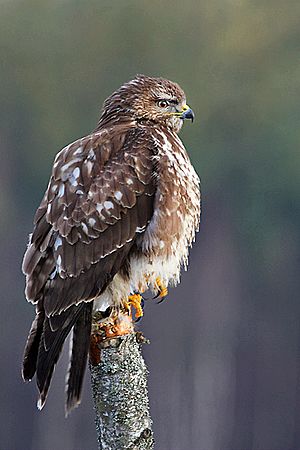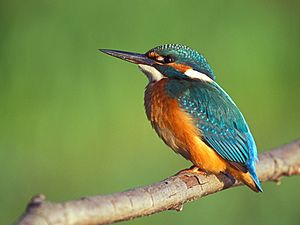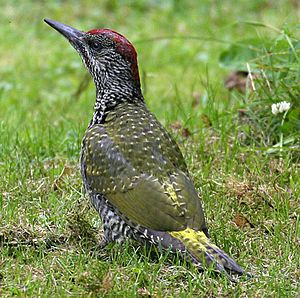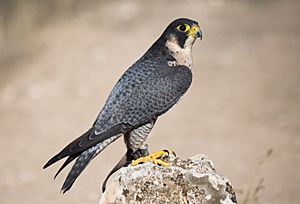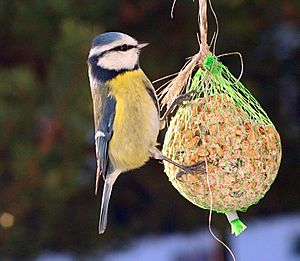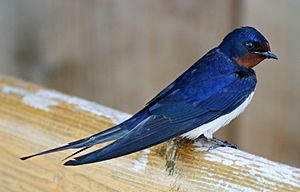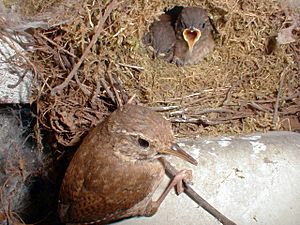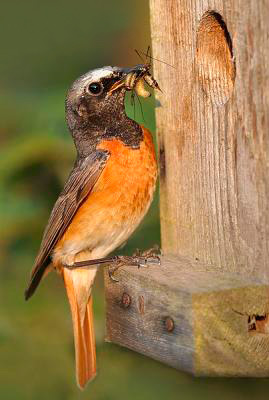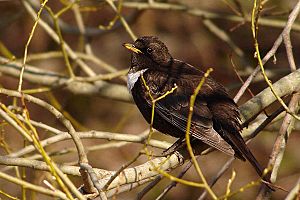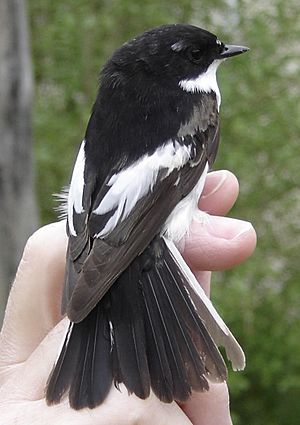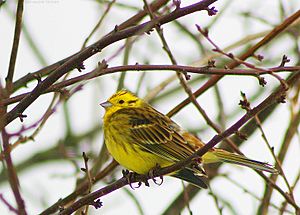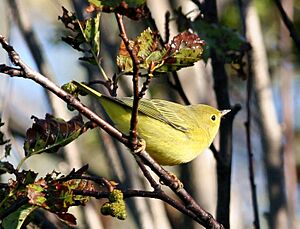List of birds of Wales facts for kids
This article lists all the different kinds of birds that have been seen living wild in Wales. Wales might have fewer types of birds that breed here compared to the whole of Britain, but it's a great place for certain birds! You can find many birds that live on moorlands, like the Red Grouse and Black Grouse. There are also huge numbers of seabirds, especially on islands like Skomer, Grassholm, and Bardsey Island.
Wales is also home to many birds that love Welsh oak woods, such as the Redstart, Pied Flycatcher, and Wood Warbler. Among the amazing birds of prey, the Red Kite is a real success story. It had disappeared from other parts of Britain but has been brought back thanks to special efforts. In winter, lots of wildfowl (like ducks and geese) and waders (birds that wade in water) come to the coast because the weather is mild. During spring and autumn, you can spot many migrant birds and vagrant birds (those that have wandered off course), especially on headlands and islands. Did you know that three-quarters of all the Red-billed Choughs in the UK live in Wales?
This list is based on information from expert bird books and reports from the Welsh Ornithological Society. The names of the birds follow the official list from the British Ornithologists' Union.
Here are some special tags you'll see next to the birds:
- (A) Accidental - This means the bird rarely or accidentally visits Wales.
- (I) Introduced - This means people brought this bird to Wales, either directly or indirectly.
In total, there are 463 different bird species on this list, with 10 of them being introduced by humans. About 150 types of birds breed in Wales every year.
Contents
- Ducks, Geese, and Swans
- Pheasants, Grouse, and Allies
- Nightjars and Allies
- Swifts
- Bustards
- Cuckoos
- Sandgrouse
- Pigeons and Doves
- Rails, Gallinules, and Coots
- Cranes
- Grebes
- Stone-curlews
- Oystercatchers
- Stilts and Avocets
- Plovers and Lapwings
- Sandpipers and Allies
- Pratincoles and Coursers
- Gulls, Terns, and Skimmers
- Skuas
- Auks, Murres, and Puffins
- Divers
- Southern Storm Petrels
- Albatrosses
- Northern Storm Petrels
- Petrels and Shearwaters
- Storks
- Boobies and Gannets
- Cormorants and Shags
- Ibises and Spoonbills
- Herons and Bitterns
- Osprey
- Hawks, Eagles, and Kites
- Barn Owls
- Owls
- Hoopoes
- Rollers
- Kingfishers
- Bee-eaters
- Woodpeckers
- Falcons and Caracaras
- Shrikes
- Vireos
- Old World Orioles
- Crows, Jays, and Magpies
- Waxwings
- Tits, Chickadees, and Titmice
- Penduline Tits
- Bearded Tit
- Larks
- Swallows
- Bush Warblers and Allies
- Long-tailed Tits
- Leaf Warblers
- Reed Warblers and Allies
- Grassbirds and Allies
- Sylviid Warblers, Parrotbills, and Allies
- Kinglets
- Wrens
- Nuthatches
- Treecreepers
- Mockingbirds and Thrashers
- Starlings
- Thrushes and Allies
- Old World Flycatchers
- Dippers
- Old World Sparrows
- Accentors
- Wagtails and Pipits
- Finches, Euphonias, and Allies
- Longspurs and Arctic Buntings
- Old World Buntings
- New World Sparrows
- Troupials and Allies
- New World Warblers
- Cardinals and Allies
- See also
Ducks, Geese, and Swans

These birds are medium to large and are perfectly built for living in water. They have webbed feet and flat bills. For many ducks, the male birds are very colorful, while the females are a duller brown. They eat a mix of plants and small animals. Lots of these birds live in Wales, especially in winter when huge numbers fly in from places like Greenland, Scandinavia, and Russia.
| Common name | Binomial | Status |
|---|---|---|
| Brent goose | Branta bernicla | |
| Red-breasted goose | Branta ruficollis | |
| Canada goose | Branta canadensis | I |
| Barnacle goose | Branta leucopsis | |
| Greylag goose | Anser anser | |
| Taiga bean goose | Anser fabalis | (A) |
| Pink-footed goose | Anser brachyrhynchus | |
| Tundra bean goose | Anser serrirostris | (A) |
| White-fronted goose | Anser albifrons | |
| Lesser white-fronted goose | Anser erythropus | (A) |
| Mute swan | Cygnus olor | |
| Bewick's swan | Cygnus columbianus | |
| Whooper swan | Cygnus cygnus | |
| Egyptian goose | Alopochen aegyptiacus | I |
| Shelduck | Tadorna tadorna | |
| Ruddy shelduck | Tadorna ferruginea | (A) |
| Mandarin duck | Aix galericulata | I |
| Garganey | Spatula querquedula | |
| Blue-winged teal | Spatula discors | (A) |
| Shoveler | Spatula clypeata | |
| Gadwall | Mareca strepera | |
| Falcated duck | Mareca falcata | |
| Wigeon | Anas penelope | |
| American wigeon | Mareca americana | (A) |
| Mallard | Anas platyrhynchos | |
| Black duck | Anas rubripes | (A) |
| Pintail | Anas acuta | |
| Teal | Anas crecca | |
| Green-winged teal | Anas carolinensis | (A) |
| Red-crested pochard | Netta rufina | I |
| Pochard | Aythya ferina | |
| Ferruginous duck | Aythya nyroca | (A) |
| Ring-necked duck | Aythya collaris | (A) |
| Tufted duck | Aythya fuligula | |
| Scaup | Aythya marila | |
| Lesser scaup | Aythya affinis | (A) |
| King eider | Somateria spectabilis | (A) |
| Eider | Somateria mollissima | |
| Surf scoter | Melanitta perspicillata | (A) |
| Velvet scoter | Melanitta fusca | |
| Common scoter | Melanitta nigra | |
| Black scoter | Melanitta americana | (A) |
| Long-tailed duck | Clangula hyemalis | |
| Goldeneye | Bucephala clangula | |
| Smew | Mergellus albellus | |
| Hooded merganser | Lophodytes cucullatus | (A) |
| Goosander | Mergus merganser | |
| Red-breasted merganser | Mergus serrator | |
| Ruddy duck | Oxyura jamaicensis | I |
Pheasants, Grouse, and Allies
These birds live on the ground, where they find their food and build their nests. They are usually plump with broad, short wings.
| Common name | Binomial | Status |
|---|---|---|
| Red grouse | Lagopus lagopus | |
| Black grouse | Lyrurus tetrix | |
| Grey partridge | Perdix perdix | |
| Pheasant | Phasianus colchicus | I |
| Quail | Coturnix coturnix | |
| Red-legged partridge | Alectorix rufa | I |
Nightjars and Allies
Nightjars are medium-sized birds that are active at night. They usually nest on the ground. They have long wings, short legs, and very short bills. Their soft feathers are colored to help them blend in with tree bark or leaves.
| Common name | Binomial | Status |
|---|---|---|
| Common nighthawk | Chordeiles minor | (A) |
| Nightjar | Caprimulgus europaeus |
Swifts
Swifts are small birds that spend most of their lives flying. They have very short legs and almost never land on the ground. Instead, they perch on vertical surfaces.
| Common name | Binomial | Status |
|---|---|---|
| Chimney swift | Chaetura pelagica | (A) |
| Alpine swift | Apus melba | (A) |
| Swift | Apus apus | |
| Pallid swift | Apus pallidus | (A) |
| Little swift | Apus affinis | (A) |
Bustards
Bustards are large, strong birds that live on open plains. They have long legs and necks and strong feet.
| Common name | Binomial | Status |
|---|---|---|
| Great bustard | Otis tarda | (A) |
| Little bustard | Tetrax tetrax | (A) |
Cuckoos
Cuckoos are birds of different sizes with slim bodies and long tails. Some types of cuckoos are famous for laying their eggs in the nests of other birds.
| Common name | Binomial | Status |
|---|---|---|
| Great spotted cuckoo | Clamator glandarius | (A) |
| Yellow-billed cuckoo | Coccyzus americanus | (A) |
| Cuckoo | Cuculus canorus |
Sandgrouse
Sandgrouse are sturdy, medium-sized birds with small heads and long, pointed wings.
| Common name | Binomial | Status |
|---|---|---|
| Pallas's sandgrouse | Syrrhaptes paradoxus | (A) |
Pigeons and Doves
Pigeons and doves are plump birds with short necks and thin bills that have a fleshy part called a cere at the base.
| Common name | Binomial | Status |
|---|---|---|
| Rock dove | Columba livia | |
| Stock dove | Columba oenas | |
| Woodpigeon | Columba palumbus | |
| Turtle dove | Streptopelia turtur | |
| Collared dove | Streptopelia decaocto |
Rails, Gallinules, and Coots
These birds mostly live in thick plants in wet areas near lakes, marshes, or rivers. Many are shy and hard to spot. Most have strong legs and long toes that help them walk on soft, uneven ground.
| Common name | Binomial | Status |
|---|---|---|
| Water rail | Rallus aquaticus | |
| Corncrake | Crex crex | (A) |
| Sora | Porzana carolina | (A) |
| Spotted crake | Porzana porzana | (A) |
| Moorhen | Gallinula chloropus | |
| Coot | Fulica atra | |
| Baillon's crake | Porzana pusilla | (A) |
| Little crake | Porzana parva | (A) |
Cranes
Cranes are large birds with long legs and long necks. Unlike herons, which look similar, cranes fly with their necks stretched out, not pulled back. Many cranes have special, loud "dances" they do when looking for a mate.
| Common name | Binomial | Status |
|---|---|---|
| Crane | Grus grus | (A) |
Grebes
Grebes are small to medium-sized diving birds with lobed toes and pointed bills. You mostly see them on lowland waters and along the coast. They eat aquatic animals and build their nests on floating platforms made of plants.
| Common name | Binomial | Status |
|---|---|---|
| Little grebe | Tachybaptus ruficollis | |
| Pied-billed grebe | Podilymbus podiceps | (A) |
| Red-necked grebe | Podiceps grisegena | |
| Great crested grebe | Podiceps cristata | |
| Slavonian grebe | Podiceps auritus | |
| Black-necked grebe | Podiceps nigricollis |
Stone-curlews
This is a small family of medium to large wading birds. They have strong black bills, big yellow eyes, and feathers that help them blend in with their surroundings.
| Common name | Binomial | Status |
|---|---|---|
| Stone-curlew | Burhinus oedicnemus | (A) |
Oystercatchers
Oystercatchers are large, easy-to-spot, and noisy wading birds. They have strong bills that they use to smash or pry open molluscs (like mussels and clams).
| Common name | Binomial | Status |
|---|---|---|
| Oystercatcher | Haematopus ostralegus |
Stilts and Avocets
This family includes fairly large wading birds. Avocets have long legs and long bills that curve upwards. Stilts have extremely long legs and long, thin, straight bills.
| Common name | Binomial | Status |
|---|---|---|
| Black-winged stilt | Himantopus himantopus | (A) |
| Avocet | Recurvirostra avosetta |
Plovers and Lapwings
These are small to medium-sized wading birds with compact bodies, short, thick necks, and long, usually pointed, wings.
| Common name | Binomial | Status |
|---|---|---|
| Lapwing | Vanellus vanellus | |
| Sociable plover | Vanellus gregarius | (A) |
| Golden plover | Pluvialis apricaria | |
| Pacific golden plover | Pluvialis fulva | (A) |
| American golden plover | Pluvialis dominica | (A) |
| Grey plover | Pluvialis squatarola | |
| Ringed plover | Charadrius hiaticula | |
| Little ringed plover | Charadrius dubius | |
| Killdeer | Charadrius vociferus | (A) |
| Kentish plover | Charadrius alexandrinus | (A) |
| Greater sand plover | Charadrius leschenaultii | (A) |
| Dotterel | Charadrius morinellus |
Sandpipers and Allies
This is a large and varied family of wading birds. Their different leg and bill lengths allow many species to feed in the same places, especially on the coast, without competing for the same food.
| Common name | Binomial | Status |
|---|---|---|
| Upland sandpiper | Bartramia longicauda | (A) |
| Whimbrel | Numenius phaeopus | |
| Hudsonian whimbrel | Numenius hudsonicus | (A) |
| Little whimbrel | Numenius minutus | (A) |
| Curlew | Numenius arquata | |
| Bar-tailed godwit | Limosa lapponica | |
| Black-tailed godwit | Limosa limosa | |
| Turnstone | Arenaria interpres | |
| Knot | Calidris canutus | |
| Ruff | Calidris pugnax | |
| Broad-billed sandpiper | Calidris falcinellus | (A) |
| Sharp-tailed sandpiper | Calidris acuminata | (A) |
| Stilt sandpiper | Calidris himantopus | (A) |
| Curlew sandpiper | Calidris ferruginea | |
| Temminck's stint | Calidris temminckii | (A) |
| Sanderling | Calidris alba | |
| Dunlin | Calidris alpina | |
| Purple sandpiper | Calidris maritima | |
| Baird's sandpiper | Calidris bairdii | (A) |
| Little stint | Calidris minuta | |
| Least sandpiper | Calidris minutilla | (A) |
| White-rumped sandpiper | Calidris fuscicollis | (A) |
| Buff-breasted sandpiper | Calidris subruficollis | (A) |
| Pectoral sandpiper | Calidris melanotos | (A) |
| Semipalmated sandpiper | Calidris pusilla | (A) |
| Long-billed dowitcher | Limnodromus scolopaceus | |
| Woodcock | Scolopax rusticola | |
| Jack snipe | Lymnocryptes minimus | |
| Great snipe | Gallinago minima | (A) |
| Snipe | Gallinago gallinago | |
| Terek sandpiper | Xenus cinerea | (A) |
| Wilson's phalarope | Phalaropus tricolor | (A) |
| Red-necked phalarope | Phalaropus lobatus | (A) |
| Grey phalarope | Phalaropus fulicarius | |
| Common sandpiper | Actitis hypoleucos | |
| Spotted sandpiper | Tringa macularius | (A) |
| Green sandpiper | Tringa ochropus | |
| Grey-tailed tattler | Tringa brevipes | (A) |
| Lesser yellowlegs | Tringa flavipes | (A) |
| Redshank | Tringa totanus | |
| Marsh sandpiper | Tringa stagnatilis | (A) |
| Wood sandpiper | Tringa glareola | |
| Spotted redshank | Tringa erythropus | |
| Greenshank | Tringa nebularia | |
| Greater yellowlegs | Tringa melanoleuca | (A) |
Pratincoles and Coursers
This is a family of slender, long-winged wading birds.
| Common name | Binomial | Status |
|---|---|---|
| Cream-coloured courser | Cursorius cursor | (A) |
| Collared pratincole | Glareola pratincola | (A) |
| Black-winged pratincole | Glareola nordmanni | (A) |
Gulls, Terns, and Skimmers
These are medium to large seabirds with grey, white, and black feathers, webbed feet, and strong bills. Many of them are good at finding food in different ways and places.
| Common name | Binomial | Status |
|---|---|---|
| Kittiwake | Rissa tridactyla | |
| Ivory gull | Pagophila eburnea | (A) |
| Sabine's gull | Xema sabini | |
| Bonaparte's gull | Chroicocephalus philadelphia | (A) |
| Black-headed gull | Chroicocephalus ridibundus | |
| Little gull | Hydrocoloeus minutus | |
| Ross's gull | Rhodostethia rosea | (A) |
| Laughing gull | Leucophaeus atricilla | (A) |
| Franklin's gull | Leucophaeus pipixcan | (A) |
| Mediterranean gull | Ichthyaetus melanocephalus | |
| Common gull | Larus canus | |
| Ring-billed gull | Larus delawarensis | |
| Great black-backed gull | Larus marinus | |
| Glaucous-winged gull | Larus glaucescens | (A) |
| Glaucous gull | Larus hyperboreus | |
| Iceland gull | Larus glaucoides | |
| Herring gull | Larus argentatus | |
| Caspian gull | Larus cachinnans | (A) |
| Yellow-legged gull | Larus michahellis | (A) |
| Lesser black-backed gull | Larus fuscus | |
| Gull-billed tern | Gelochelidon nilotica | (A) |
| Caspian tern | Hydroprogne caspia | (A) |
| Royal tern | Thalasseus maximus | (A) |
| Lesser crested tern | Thalasseus bengalensis | (A) |
| Sandwich tern | Thalasseus sandvicensis | |
| Elegant tern | Thalasseus elegans | (A) |
| Little tern | Sternula albifrons | |
| Bridled tern | Onychoprion anaethetus | (A) |
| Sooty tern | Onychoprion fuscatus | (A) |
| Roseate tern | Sterna dougallii | |
| Common tern | Sterna hirundo | |
| Arctic tern | Sterna paradisaea | |
| Forster's tern | Sterna forsteri | (A) |
| Whiskered tern | Chlidonias hybrida | (A) |
| White-winged black tern | Chlidonias leucoptera | (A) |
| Black tern | Chlidonias niger |
Skuas
Skuas are medium to large seabirds, usually grey or brown. They have sharp claws and a hooked bill. They are known for chasing other seabirds to make them drop their food, which the skuas then eat.
| Common name | Binomial | Status |
|---|---|---|
| South Polar skua | Stercorarius maccormicki | |
| Great skua | Stercorarius skua | |
| Pomarine skua | Stercorarius pomarinus | |
| Arctic skua | Stercorarius parasiticus | |
| Long-tailed skua | Stercorarius longicaudus |
Auks, Murres, and Puffins
This family of seabirds looks a bit like penguins with their black and white colors and upright stance, but they can fly! Sadly, the Great Auk is now extinct.
| Common name | Binomial | Status |
|---|---|---|
| Little auk | Alle alle | |
| Common guillemot | Uria aalge | |
| Razorbill | Alca torda | |
| Black guillemot | Cepphus grylle | |
| Puffin | Fratercula arctica |
Divers
Divers are aquatic birds, about the size of a large duck, but they are not related to ducks. They are excellent swimmers and can fly well, but they are very clumsy on land because their legs are set far back on their bodies. They eat fish and other water animals. All divers found in Wales are visitors and do not breed here.
| Common name | Binomial | Status |
|---|---|---|
| Red-throated diver | Gavia stellata | |
| Black-throated diver | Gavia arctica | |
| Great northern diver | Gavia immer | |
| White-billed diver | Gavia adamsii | (A) |
Southern Storm Petrels
These are the smallest seabirds. They eat tiny plankton and small fish, which they pick from the water's surface while hovering. They nest in groups on the ground, often in burrows.
| Common name | Binomial | Status |
|---|---|---|
| Wilson's storm petrel | Oceanites oceanicus | (A) |
Albatrosses
Albatrosses are among the largest flying birds, with long, narrow wings that help them glide over the ocean. Most of them live in the Southern Hemisphere, and only a few wander into the North Atlantic.
| Common name | Binomial | Status |
|---|---|---|
| Black-browed albatross | Thalassarche melanophris | (A) |
Northern Storm Petrels
Like their southern relatives, these are also very small seabirds. They feed on plankton and small fish from the surface of the water, often hovering as they do so. They nest in groups on the ground, usually in burrows.
| Common name | Binomial | Status |
|---|---|---|
| Storm petrel | Hydrobates pelagicus | |
| Leach's petrel | Hydrobates leucorrhous |
Petrels and Shearwaters
These birds spend most of their lives far out at sea (they are pelagic). They have long, narrow wings and tube-shaped nostrils. They eat fish, squid, and other sea creatures. They only come to land to breed in colonies, nesting in burrows or on cliffs.
| Common name | Binomial | Status |
|---|---|---|
| Fulmar | Fulmarus glacialis | |
| Cory's shearwater | Calonectris borealis | (A) |
| Sooty shearwater | Ardenna griseus | |
| Great shearwater | Ardenna gravis | (A) |
| Manx shearwater | Puffinus puffinus | |
| Balearic shearwater | Puffinus mauretanicus | |
| Macaronesian shearwater | Puffinus baroli | (A) |
Storks
Storks are large, heavy wading birds with long legs, long necks, and strong, thick bills. They have wide wings and fly with their necks stretched out.
| Common name | Binomial | Status |
|---|---|---|
| Black stork | Ciconia nigra | (A) |
| White stork | Ciconia ciconia | (A) |
Boobies and Gannets
Gannets are large seabirds that dive headfirst into the water to catch fish. They nest in big groups. They have a sleek, torpedo-shaped body, long, narrow, pointed wings, and a fairly long tail.
| Common name | Binomial | Status |
|---|---|---|
| Gannet | Morus bassanus |
Cormorants and Shags
Cormorants are medium to large water birds with mostly dark feathers and colored skin on their faces. Their bills are long, thin, and sharply hooked, perfect for catching fish and other water creatures. They nest in groups, usually by the sea.
| Common name | Binomial | Status |
|---|---|---|
| Cormorant | Phalacrocorax carbo | |
| Shag | Gulosus aristotelis |
Ibises and Spoonbills
This family includes long-legged, long-necked wading birds. Ibises have long, curved bills. Spoonbills have a flat bill that is wider at the tip.
| Common name | Binomial | Status |
|---|---|---|
| Glossy ibis | Plegadis falcinellus | (A) |
| Spoonbill | Platalea leucorodia |
Herons and Bitterns
Herons and egrets are medium to large wading birds with long necks and legs. Bitterns usually have shorter necks and are more secretive. All of them fly with their necks pulled back. They use their sharp bills to catch fish, amphibians, and other small animals. Many types nest in groups, often in trees.
| Common name | Binomial | Status |
|---|---|---|
| Bittern | Botaurus stellaris | |
| American bittern | Botaurus lentiginosus | (A) |
| Little bittern | Ixobrychus minutus | (A) |
| Night heron | Nycticorax nycticorax | (A) |
| Green heron | Butorides virescens | (A) |
| Squacco heron | Ardeola ralloides | (A) |
| Cattle egret | Bubulcus ibis | |
| Grey heron | Ardea cinerea | |
| Purple heron | Ardea purpurea | (A) |
| Great white egret | Ardea alba | (A) |
| Little egret | Egretta garzetta |
Osprey
The Osprey is a large bird of prey that eats fish. It belongs to its own special family. It's mostly brown on top and white underneath, with long, angled wings. In Wales, it's mainly a bird that passes through during migration, but it has recently started to breed here.
| Common name | Binomial | Status |
|---|---|---|
| Osprey | Pandion haliaetus |
Hawks, Eagles, and Kites
This family includes hawks, buzzards, eagles, kites, and harriers. These birds of prey have very large, strong, hooked beaks for tearing meat from their prey. They also have strong legs, powerful talons (claws), and excellent eyesight.
| Common name | Binomial | Status |
|---|---|---|
| Honey-buzzard | Pernis apivorus | |
| Golden eagle | Aquila chrysaetos | (A) |
| Sparrowhawk | Accipiter nisus | |
| Goshawk | Accipiter gentilis | |
| Marsh harrier | Circus aeruginosus | |
| Hen harrier | Circus cyaneus | |
| Pallid harrier | Circus macrourus | (A) |
| Montagu's harrier | Circus pygargus | (A) |
| Red kite | Milvus milvus | |
| Black kite | Milvus migrans | (A) |
| White-tailed eagle | Haliaaetus albicilla | (A) |
| Rough-legged buzzard | Buteo lagopus | (A) |
| Buzzard | Buteo buteo |
Barn Owls
Barn owls are medium to large owls with big heads and unique heart-shaped faces. They have long, strong legs with powerful talons.
| Common name | Binomial | Status |
|---|---|---|
| Barn owl | Tyto alba |
Owls
Typical owls are solitary birds of prey that are active at night. They have large eyes that face forward and good hearing. They have a hawk-like beak and a clear circle of feathers around each eye, called a facial disc.
| Common name | Binomial | Status |
|---|---|---|
| Little owl | Athene noctua | |
| Scops owl | Otus scops | (A) |
| Long-eared owl | Asio otus | |
| Short-eared owl | Asio flammeus | |
| Snowy owl | Bubo scandiaca | (A) |
| Tawny owl | Strix aluco |
Hoopoes
The Hoopoe is a unique bird in its own family. It has a long, curved bill, a crest on its head, and black and white striped wings and tail.
| Common name | Binomial | Status |
|---|---|---|
| Hoopoe | Upupa epops |
Rollers
This is a small family of colorful, medium-sized birds that look a bit like crows. They mainly eat insects.
| Common name | Binomial | Status |
|---|---|---|
| Roller | Coracias garrulus | (A) |
Kingfishers
Kingfishers are medium-sized birds with large heads, long, pointed bills, short legs, and stubby tails. There are about 93 species worldwide, but only one is commonly found in Wales.
| Common name | Binomial | Status |
|---|---|---|
| Kingfisher | Alcedo atthis |
Bee-eaters
Bee-eaters are a group of colorful birds with slender bodies and usually long central tail feathers.
| Common name | Binomial | Status |
|---|---|---|
| Bee-eater | Merops apiaster | (A) |
Woodpeckers
Woodpeckers are small to medium-sized birds with chisel-like beaks, short legs, stiff tails, and long tongues for catching insects. Many woodpeckers are known for loudly tapping on tree trunks with their beaks.
| Common name | Binomial | Status |
|---|---|---|
| Wryneck | Jynx tranquila | |
| Lesser spotted woodpecker | Dryobates minor | |
| Great spotted woodpecker | Dendrocopos major | |
| Green woodpecker | Picus viridis |
Falcons and Caracaras
This family includes small to medium-sized birds of prey that are active during the day. They have pointed wings. They don't build their own nests and mostly catch their prey while flying.
| Common name | Binomial | Status |
|---|---|---|
| Kestrel | Falco tinnunculus | |
| Red-footed falcon | Falco vespertinus | (A) |
| Merlin | Falco columbarius | |
| Hobby | Falco subbuteo | |
| Gyr falcon | Falco rusticolus | (A) |
| Peregrine | Falco peregrinus |
Shrikes
Shrikes are passerine birds known for their habit of catching other birds and small animals and sticking them on thorns. A typical shrike's beak is hooked, like a bird of prey.
| Common name | Binomial | Status |
|---|---|---|
| Red-backed shrike | Lanius collurio | (A) |
| Turkestan shrike | Lanius phoenicuroides | |
| Lesser grey shrike | Lanius minor | (A) |
| Great grey shrike | Lanius excubitor | |
| Woodchat shrike | Lanius senator | (A) |
Vireos
Vireos are a group of small to medium-sized passerine birds found only in the New World (the Americas).
| Common name | Binomial | Status |
|---|---|---|
| Red-eyed vireo | Vireo olivaceus | (A) |
Old World Orioles
Orioles are colorful, medium-sized passerine birds known for their loud, flute-like songs.
| Common name | Binomial | Status |
|---|---|---|
| Golden oriole | Oriolus oriolus |
Crows, Jays, and Magpies
Crows and their relatives are fairly large birds with strong bills. They are usually very smart and can adapt to many different places.
| Common name | Binomial | Status |
|---|---|---|
| Jay | Garrulus glandarius | |
| Magpie | Pica pica | |
| Nutcracker | Nucifraga caryocatactes | (A) |
| Chough | Pyrrhocorax pyrrhocorax | |
| Jackdaw | Corvus monedula | |
| Rook | Corvus frugilegus | |
| Carrion crow | Corvus corone | |
| Hooded crow | Corvus cornix | |
| Raven | Corvus corax |
Waxwings
Waxwings are a group of passerine birds with soft, silky feathers. They have unique red tips on some of their wing feathers.
| Common name | Binomial | Status |
|---|---|---|
| Waxwing | Bombycilla garrulus | |
| Cedar waxwing | Bombycilla cedrorum | (A) |
Tits, Chickadees, and Titmice
Tits are mostly small, stocky woodland birds with short, stout bills. They are adaptable birds that eat a mix of seeds and insects.
| Common name | Binomial | Status |
|---|---|---|
| Coal tit | Periparus ater | |
| Marsh tit | Poecile palustris | |
| Willow tit | Poecile montana | |
| Blue tit | Cyanistes caeruleus | |
| Great tit | Parus major |
Penduline Tits
These are small birds with very pointed bills. They build nests that look like purses, hanging from branches.
| Common name | Binomial | Status |
|---|---|---|
| Penduline tit | Remiz pendulinus | (A) |
Bearded Tit
This bird is the only one in its family. It lives in reed beds across Europe and Asia.
| Common name | Binomial | Status |
|---|---|---|
| Bearded tit | Panurus biarmicus | (A) |
Larks
Larks are small ground birds often known for their amazing songs and display flights. Most larks don't have very bright feathers. They eat insects and seeds.
| Common name | Binomial | Status |
|---|---|---|
| Woodlark | Lullula arborea | (A) |
| Skylark | Alauda arvensis | |
| Crested lark | Galerida cristata | (A) |
| Shore lark | Eremophila alpestris | (A) |
| Short-toed lark | Calandrella brachydactyla | (A) |
| Black lark | Melanocorypha yeltoniensis | (A) |
Swallows
The swallow family is built for catching food while flying. They have slim, streamlined bodies, long, pointed wings, and a short bill with a wide mouth.
| Common name | Binomial | Status |
|---|---|---|
| Sand martin | Riparia riparia | |
| Crag martin | Ptyonoprogne rupestris | (A) |
| Swallow | Hirundo rustica | |
| House martin | Delichon urbicum | |
| Red-rumped swallow | Cecropis daurica | (A) |
Bush Warblers and Allies
The birds in this family are found in Africa, Asia, and Polynesia. Scientists are still learning about how they are related to other birds.
| Common name | Binomial | Status |
|---|---|---|
| Cetti's warbler | Cettia cetti |
Long-tailed Tits
These are small birds with long tails that usually live in flocks for most of the year.
| Common name | Binomial | Status |
|---|---|---|
| Long-tailed tit | Aegithalos caudatus |
Leaf Warblers
Leaf warblers are a family of small birds that eat insects. They are mostly found in Europe and Asia. They come in different sizes, often with green feathers on top and yellow underneath, or more muted grey-green to grey-brown colors.
| Common name | Binomial | Status |
|---|---|---|
| Wood warbler | Phylloscopus sibalatrix | |
| Western Bonelli's warbler | Phylloscopus bonelli | (A) |
| Hume's warbler | Phylloscopus humei | (A) |
| Yellow-browed warbler | Phylloscopus inornatus | |
| Pallas's warbler | Phylloscopus proregulus | (A) |
| Radde's warbler | Phylloscopus schwarzi | (A) |
| Dusky warbler | Phylloscopus fuscatus | (A) |
| Willow warbler | Phylloscopus trochilus | |
| Chiffchaff | Phylloscopus collybita | (A) |
| Iberian chiffchaff | Phylloscopus ibericus | (A) |
| Greenish warbler | Phylloscopus trochiloides | (A) |
| Arctic warbler | Phylloscopus borealis | (A) |
Reed Warblers and Allies
Birds in this family are usually quite large for "warblers." Most are plain olive-brown on top with yellow or beige underneath. They are often found in open woodlands, reed beds, or tall grass.
| Common name | Binomial | Status |
|---|---|---|
| Great reed warbler | Acrocephalus arundinaceus | (A) |
| Aquatic warbler | Acrocephalus paludicola | (A) |
| Sedge warbler | Acrocephalus schoenobaenus | |
| Paddyfield warbler | Acrocephalus agricola | (A) |
| Blyth's reed warbler | Acrocephalus dumetorum | (A) |
| Reed warbler | Acrocephalus scirpaceus | |
| Marsh warbler | Acrocephalus palustris | (A) |
| Booted warbler | Iduna caligata | (A) |
| Melodious warbler | Hippolais polyglotta | (A) |
| Icterine warbler | Hippolais icterina | (A) |
Grassbirds and Allies
Grassbirds are a family of small insect-eating songbirds found mostly in Europe, Asia, Africa, and Australia. They are small birds with tails that are usually long and pointed, and they tend to be dull brownish or buffy all over.
| Common name | Binomial | Status |
|---|---|---|
| Lanceolated warbler | Locustella lanceolata | (A) |
| River warbler | Locustella fluviatilis | (A) |
| Savi's warbler | Locustella luscinioides | (A) |
| Grasshopper warbler | Locustella naevia |
Sylviid Warblers, Parrotbills, and Allies
This is a group of small, insect-eating passerine birds. Most of them don't look very special, but many have unique and beautiful songs.
| Common name | Binomial | Status |
|---|---|---|
| Blackcap | Sylvia atricapilla | |
| Garden warbler | Sylvia borin | |
| Barred warbler | Curruca nisoria | (A) |
| Lesser whitethroat | Curruca curruca | |
| Western Orphean warbler | Curruca hortensis | (A) |
| Rüppell's warbler | Curruca ruppeli | (A) |
| Sardinian warbler | Curruca melanocephala | (A) |
| Western subalpine warbler | Curruca iberiae | (A) |
| Eastern subalpine warbler | Curruca cantillans | (A) |
| whitethroat | Curruca communis | |
| Marmora's warbler | Curruca sarda | (A) |
| Dartford warbler | Curruca undata |
Kinglets
Kinglets, also called crests, are a small group of birds. They are sometimes grouped with Old World warblers, but they are often given their own family because they also look like titmice.
| Common name | Binomial | Status |
|---|---|---|
| Common firecrest | Regulus ignicapilla | |
| Goldcrest | Regulus regulus |
Wrens
Wrens are small and often hard to see birds, except for their loud songs! They have short wings and thin, downward-curved bills.
| Common name | Binomial | Status |
|---|---|---|
| Wren | Troglodytes troglodytes |
Nuthatches
Nuthatches are small woodland birds with a special ability: they can climb down trees head-first! Other birds can usually only climb upwards.
| Common name | Binomial | Status |
|---|---|---|
| Nuthatch | Sitta europaea |
Treecreepers
Treecreepers are small woodland birds, brown on top and white underneath. They have thin, pointed, downward-curved bills, which they use to pull insects out of tree bark.
| Common name | Binomial | Status |
|---|---|---|
| Treecreeper | Certhia familiaris |
Mockingbirds and Thrashers
These are medium-sized passerine birds with long tails. Some are famous for being able to copy sounds, like the songs of other birds.
| Common name | Binomial | Status |
|---|---|---|
| Grey catbird | Dumetella carolinensis | (A) |
Starlings
Starlings are small to medium-sized passerine birds with strong feet. They fly strongly and directly, and most of them like to live in large groups.
| Common name | Binomial | Status |
|---|---|---|
| Rose-coloured starling | Pastor roseus | (A) |
| Starling | Sturnus vulgaris |
Thrushes and Allies
Thrushes and chats are plump birds with soft feathers. They are small to medium-sized and eat insects, or sometimes a mix of things. They often find food on the ground. Many of them have beautiful songs.
| Common name | Binomial | Status |
|---|---|---|
| Swainson's thrush | Catharus ustulatus | (A) |
| Grey-cheeked thrush | Catharus minimus | (A) |
| Song thrush | Turdus philomelos | |
| Mistle thrush | Turdus viscivorus | (A) |
| Redwing | Turdus iliacus | |
| Blackbird | Turdus merula | |
| Eyebrowed thrush | Turdus obscurus | (A) |
| Fieldfare | Turdus pilaris | |
| Ring ouzel | Turdus torquatus | |
| Black-throated thrush | Turdus atrogularis | |
| Red-throated thrush | Turdus ruficollis | (A) |
| Dusky thrush | Turdus eunomus | (A) |
| American robin | Turdus viscivorus | (A) |
Old World Flycatchers
Flycatchers are small birds that fly out from a perch to catch insects in the air.
| Common name | Binomial | Status |
|---|---|---|
| Spotted flycatcher | Muscicapa striata | |
| Robin | Erithacus rubecula | |
| Bluethroat | Luscinia svecica | (A) |
| Thrush nightingale | Luscinia luscinia | (A) |
| Nightingale | Luscinia megarhynchos | (A) |
| White-throated robin | Irania gutturalis | (A) |
| Red-flanked bluetail | Tarsiger cyanurus | (A) |
| Red-breasted flycatcher | Ficedula parva | (A) |
| Pied flycatcher | Ficedula hypoleuca | |
| Collared flycatcher | Ficedula albicollis | (A) |
| Black redstart | Phoenicurus ochruros | |
| Redstart | Phoenicurus phoenicurus | |
| Moussier's redstart | Phoenicurus moussieri | (A) |
| Rock thrush | Monticola saxatilis | (A) |
| Blue rock thrush | Monticola solitarius | (A) |
| Whinchat | Saxicola rubetra | |
| Stonechat | Saxicola torquata | |
| Wheatear | Oenanthe oenanthe | |
| Isabelline wheatear | Oenanthe isabellina | (A) |
| Desert wheatear | Oenanthe deserti | (A) |
| Western black-eared wheatear | Oenanthe hispanica | (A) |
| Pied wheatear | Oenanthe pleschanka | (A) |
Dippers
Dippers are a group of perching birds that live near water in the Americas, Europe, and Asia. They are named for their bobbing or "dipping" movements.
| Common name | Binomial | Status |
|---|---|---|
| Dipper | Cinclus cinclus |
Old World Sparrows
Sparrows are usually small, plump, brownish or grayish birds with short tails and short, strong beaks. They eat seeds and also small insects.
| Common name | Binomial | Status |
|---|---|---|
| Tree sparrow | Passer montanus | |
| Spanish sparrow | Passer hispaniolensis | (A) |
| House sparrow | Passer domesticus |
Accentors
This is a small family of plain, quiet, insect-eating birds with thin, pointed bills.
| Common name | Binomial | Status |
|---|---|---|
| Alpine accentor | Prunella collaris | (A) |
| Dunnock | Prunella modularis |
Wagtails and Pipits
This family includes small passerine birds with medium to long tails. They are slender, insect-eating birds that find their food on the ground in open areas.
| Common name | Binomial | Status |
|---|---|---|
| Western yellow wagtail | Motacilla flava | (A) |
| Eastern yellow wagtail | Motacilla tschutschensis | (A) |
| Citrine wagtail | Motacilla citreola | (A) |
| Grey wagtail | Motacilla cinerea | |
| White wagtail | Motacilla alba | |
| Richard's pipit | Anthus richardi | |
| Blyth's pipit | Anthus godlewskii | (A) |
| Tawny pipit | Anthus campestris | (A) |
| Meadow pipit | Anthus pratensis | |
| Tree pipit | Anthus trivialis | |
| Olive-backed pipit | Anthus hodgsoni | (A) |
| Pechora pipit | Anthus gustavi | (A) |
| Red-throated pipit | Anthus cervinus | (A) |
| Buff-bellied pipit | Anthus rubescens | (A) |
| Water pipit | Anthus spinoletta | |
| Rock pipit | Anthus petrosus |
Finches, Euphonias, and Allies
These are seed-eating passerine birds that are small to medium-large. They have strong beaks, usually shaped like a cone, and in some species, very large.
| Common name | Binomial | Status |
|---|---|---|
| Chaffinch | Fringilla coelebs | |
| Brambling | Fringilla montifringilla | |
| Hawfinch | Coccothraustes coccothraustes | |
| Bullfinch | Pyrrhula pyrrhula | |
| Common rosefinch | Carpodacus erythrinus | (A) |
| Greenfinch | Chloris chloris | |
| Twite | Linaria flavirostris | |
| Linnet | Linaria cannabina | |
| Common redpoll | Acanthis flammea | (A) |
| Lesser redpoll | Acanthis cabaret | |
| Arctic redpoll | Acanthis hornemanni | (A) |
| Common crossbill | Loxia curvirostra | |
| Two-barred crossbill | Loxia leucoptera | (A) |
| Goldfinch | Carduelis carduelis | |
| Serin | Serinus serinus | (A) |
| Siskin | Spinus spinus |
Longspurs and Arctic Buntings
This family of birds used to be grouped with New World sparrows, but they are different in many ways. They are usually found in open grassy areas.
| Common name | Binomial | Status |
|---|---|---|
| Lapland bunting | Calcarius lapponicus | |
| Snow bunting | Plectrophenax nivalis |
Old World Buntings
This is a large family of seed-eating passerine birds with a uniquely shaped bill.
| Common name | Binomial | Status |
|---|---|---|
| Corn bunting | Emberiza calandra | (A) |
| Yellowhammer | Emberiza citrinella | |
| Pine bunting | Emberiza leucocephalos | (A) |
| Rock bunting | Emberiza cia | (A) |
| Ortolan bunting | Emberiza hortulana | (A) |
| Cretzschmar's bunting | Emberiza caesia | (A) |
| Cirl bunting | Emberiza cirlus | (A) |
| Little bunting | Emberiza pusilla | (A) |
| Rustic bunting | Emberiza rustica | (A) |
| Yellow-breasted bunting | Emberiza aureola | (A) |
| Black-headed bunting | Emberiza melanocephala | (A) |
| Reed bunting | Emberiza schoeniclus |
New World Sparrows
Before 2017, these birds were thought to be part of the Emberizidae family. Most of these birds are called sparrows, but they are not closely related to the Old World sparrows. Many of them have distinct patterns on their heads.
| Common name | Binomial | Status |
|---|---|---|
| Dark-eyed junco | Junco hyemalis | (A) |
| White-throated sparrow | Zonotrichia albicollis | (A) |
| Song sparrow | Melospiza melodia | (A) |
Troupials and Allies
This group includes small to medium-sized, often colorful passerine birds found only in the New World.
| Common name | Binomial | Status |
|---|---|---|
| Bobolink | Dolichonyx oryzivorus | (A) |
| Baltimore oriole | Icterus galbula | (A) |
| Brown-headed cowbird | Molothrus ater | (A) |
New World Warblers
This is a group of small, often colorful passerine birds found only in the New World. Most of them live in trees and eat insects.
| Common name | Binomial | Status |
|---|---|---|
| Black-and-white warbler | Mniotilta varia | (A) |
| Common yellowthroat | Geothlypas trichas | (A) |
| Blackburnian warbler | Setophaga fusca | (A) |
| Yellow warbler | Setophaga petechia | (A) |
| Blackpoll warbler | Setophaga striata | (A) |
| Yellow-rumped warbler | Setophaga coronata | (A) |
Cardinals and Allies
Cardinals are a family of strong, seed-eating birds with powerful bills. They usually live in open woodlands. The male and female birds often have different colored feathers.
| Common name | Binomial | Status |
|---|---|---|
| Summer tanager | Piranga rubra | (A) |
| Rose-breasted grosbeak | Pheucticus ludovicianus | (A) |
| Indigo bunting | Passerina cyanea | (A) |
See also
- List of birds of Great Britain
- British avifauna
- Lists of birds by region


